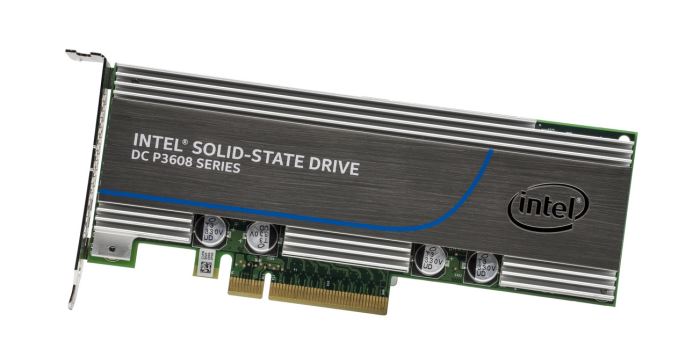Intel Announces SSD DC P3608 Series
by Billy Tallis on September 23, 2015 12:00 PM EST- Posted in
- Intel
- Storage
- SSDs
- PCIe SSD
- Enterprise SSDs

Intel is introducing a new family of enterprise PCIe SSDs with the aim of outperforming their existing DC P3600 series and even beating the DC P3700 series in many metrics. To do this, they've essentially put two P3600 SSDs on to one expansion card and widened the interface to 8 lanes of PCIe 3.0. While this does come across as a bit of a quick and dirty solution, it is a very straightforward way for Intel to deliver higher performance, albeit at the cost of sharply increased power consumption.
The SSD DC P3608 appears to the system as two individual NVMe drives behind a PLX PCIe switch chip. This means that extracting full performance from this card will require software RAID-0 or some similar software load-balancing solution. A new version of Intel's Rapid Storage Toolkit for Enterprise (RSTe) drivers will be providing this capability. The overhead of the PCIe switch and managing two independent controllers means that the P3608 cannot attain an oughtright doubling of the P3600's performance.
The inclusion of two SSD controllers and a PCIe switch chip also drives idle power consumption up to 11.5W and makes a 2.5" form factor impossible, so the P3608 series will only be available as a half-height half-length PCIe expansion card. Intel's not too worried about the form factor constraint, because they're now able to make full use of the 8-lane PCIe slots that are the most common in the sort of servers these drives are typically used in.
The SSD DC P3608 is available in three capacities, with the smallest 1.6TB configuration having more overprovisioning to boost random write speeds. Active power consumption varies with capacity, but all models support a power governor setting to limit power consumption to 35W or 25W instead of the worst-case 40W. Intel has provided us with a 1.6TB SSD DC P3608, so a full review is on its way.
| Intel Enterprise PCIe SSDs | |||||
| P3608 4TB | P3608 3.2TB | P3608 1.6TB | P3700 1.6TB | P3600 1.6TB | |
| Capacity | 4TB | 3.2TB | 1.6TB | 1.6TB | 1.6TB |
| 4kB Random Read (IOPS) | 850,000 | 850,000 | 850,000 | 450,000 | 450,000 |
| 4kB Random Write (IOPS) | 50,000 | 80,000 | 150,000 | 150,000 | 56,000 |
| Sequential Read (MB/s) | 5,000 | 4,500 | 5,000 | 2,800 | 2,600 |
| Sequential Write (MB/s) | 3,000 | 2,600 | 2,000 | 1,900 | 1,600 |
| Idle Power (W) | 11.5 | 11.5 | 11.5 | 4 | 4 |
| Read Power (W) | 20 | 18 | 18 | 10 | 9 |
| Write Power (W) | 40 | 35 | 30 | 22 | 20 |
| Form Factor | PCIe 3.0 x8 HHHL | PCIe 3.0 x4 HHHL or 2.5" 15mm | |||
| Endurance Rating | 3 DWPD | 15 DWPD | 3 DWPD | ||
| Warranty | 5 years | ||||
Source: Intel










27 Comments
View All Comments
makerofthegames - Wednesday, September 23, 2015 - link
Why does random write performance go down with increasing size, on the P3608? 50KIOPS at 4TB, 80KIOPS at 3.2TB, and 150KIOPS at 1.6TB? Is that a misprint or is there a reason for the decreasing performance?nathanddrews - Wednesday, September 23, 2015 - link
It could be that they are using higher-density NAND in fewer packages in the higher capacity drives, while the lower capacity drives are still using lower-density (older) NAND. I don't know if this is why, but it's a possibility.baconforall - Wednesday, September 23, 2015 - link
"...the smallest 1.6TB configuration having more overprovisioning to boost random write speeds."makerofthegames - Thursday, September 24, 2015 - link
They got a 3x performance boost out of overprovisioning?! What did they do, use 4TB raw capacity on all three of them?baconforall - Thursday, September 24, 2015 - link
It sure looks like they did!http://www.anandtech.com/show/6489/playing-with-op
BrokenCrayons - Wednesday, September 23, 2015 - link
I'll take two 4TB models thanks. :)Shadow7037932 - Wednesday, September 23, 2015 - link
That would be one kidney.ddriver - Thursday, September 24, 2015 - link
I highly doubt it will be that cheap.BrokenCrayons - Thursday, September 24, 2015 - link
Totally worth it. Kidneys are overrated anyway.Lolimaster - Wednesday, September 23, 2015 - link
I really think PCI-E sata-e NVM drives are doomed, the power consumption is simply too high. Considering that an spinning HDD consumes at most 8-10w writting data.